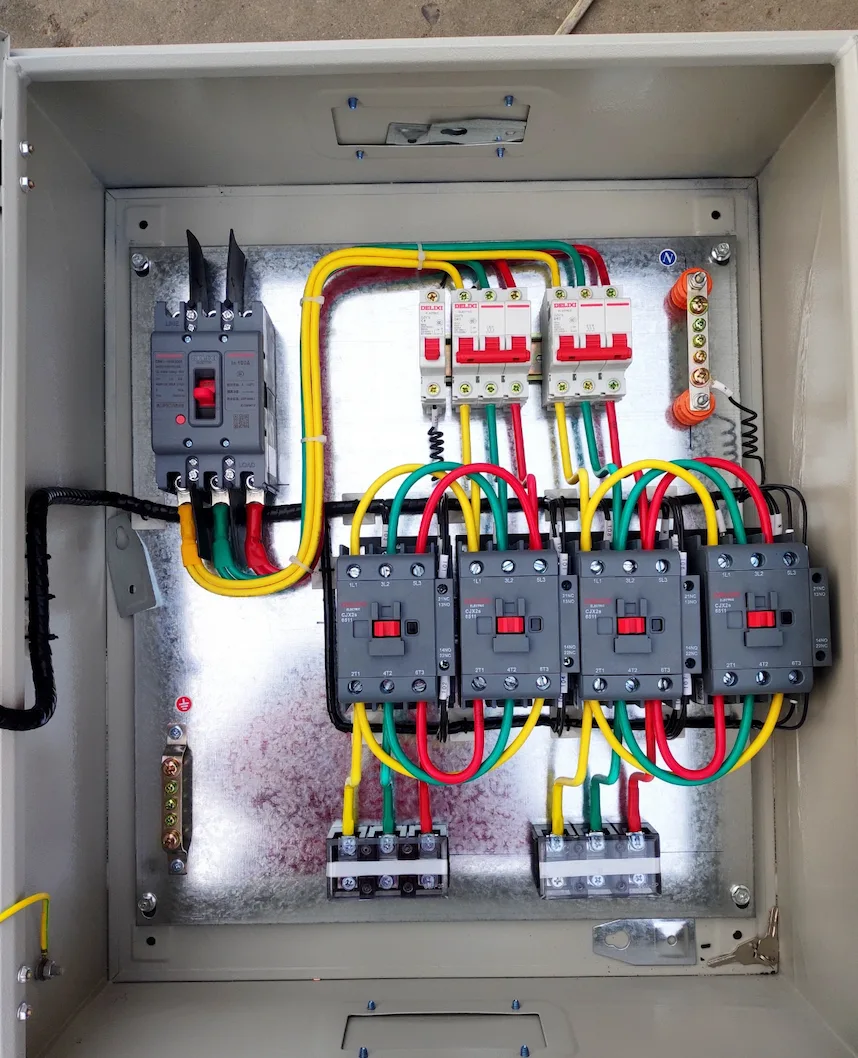When designing electrical distribution systems, choosing the right busbar insulator can mean the difference between decades of reliable operation and costly system failures. While both indoor and outdoor busbar insulators serve the fundamental purpose of electrical isolation and mechanical support, their design requirements, materials, and performance characteristics differ significantly based on their operating environments.
Quick Answer: Indoor vs Outdoor Busbar Insulators
Indoor busbar insulators prioritize compactness, cost-effectiveness, and controlled environment performance, typically using materials like epoxy resin or BMC/SMC composites. Outdoor busbar insulators focus on environmental resistance, UV protection, and weathering durability, commonly utilizing porcelain, UV-resistant polymers, or specially treated composite materials.
Understanding Busbar Insulators: The Foundation

Busbar insulators are specialized components that electrically isolate metallic conductors (busbars) from their surroundings while providing essential mechanical support. In modern electrical systems, these insulators prevent short circuits, reduce energy losses, and ensure personnel safety by maintaining proper electrical clearances.
Core Functions Across All Applications
- Electrical Isolation: Prevent current leakage between busbars and grounded structures
- Mechanical Support: Withstand operational forces from thermal expansion and electromagnetic stress
- Safety Barrier: Protect against accidental contact and electrical faults
- Structural Integrity: Maintain system stability under various load conditions
Indoor Busbar Insulators: Optimized for Controlled Environments

Indoor applications benefit from controlled environmental conditions, allowing for more specialized designs focused on electrical performance and space efficiency.
Design Characteristics
Compact Construction
Indoor insulators typically feature smaller profiles to maximize space utilization in enclosed equipment like switchgear and control panels. The controlled environment eliminates the need for extensive weatherproofing, allowing for more streamlined designs.
Material Optimization
Common materials include:
- Epoxy Resin: Excellent electrical properties with high dielectric strength
- BMC/SMC Composites: Bulk molding compounds offering superior thermal resistance up to 140°C
- Cycloaliphatic Epoxy: Enhanced mechanical strength for high-stress applications
- Polyester Compounds: Cost-effective solutions for lower voltage applications
Performance Priorities
– High dielectric strength for compact designs
– Thermal stability for heat-generating equipment
– Dimensional precision for tight assembly tolerances
– Fire resistance for safety compliance
Typical Indoor Applications
Switchgear Systems
Indoor switchgear requires insulators that can handle high current densities while maintaining compact profiles. Support insulators in these applications typically operate at voltages from 5kV to 38kV, with specialized epoxy designs providing reliable long-term performance.
Control Panels and Motor Control Centers
Low-voltage applications (up to 1kV) use smaller support insulators designed for easy installation and maintenance access. These systems prioritize space efficiency and cost-effectiveness.
Data Centers and UPS Systems
Modern data center applications demand insulators with excellent thermal management properties and low electromagnetic interference characteristics to support critical power distribution.
Industrial Distribution Boards
Manufacturing facilities require robust insulators capable of withstanding vibration and thermal cycling from heavy machinery operations.
Outdoor Busbar Insulators: Built for Environmental Challenges

Outdoor installations face significantly harsher conditions, requiring insulators designed for long-term environmental exposure and extreme weather resistance.
Environmental Challenges
UV Radiation Exposure
Continuous sunlight exposure can degrade many insulator materials over time, causing surface cracking, color changes, and eventual performance degradation. Outdoor insulators must incorporate UV-resistant materials or protective treatments.
Temperature Extremes
Outdoor installations experience wide temperature variations, from sub-zero winter conditions to extreme summer heat. Thermal cycling can cause mechanical stress and material fatigue if not properly addressed.
Moisture and Contamination
Rain, snow, humidity, and environmental pollutants create challenging conditions for electrical insulation. Proper sealing and hydrophobic surface treatments become critical.
Mechanical Stress
Wind loading, ice accumulation, and seismic activity impose additional mechanical demands on outdoor installations.
Design Solutions
Enhanced Material Selection
– Porcelain: Traditional choice offering excellent weathering resistance and long service life (20+ years)
– Composite Polymers: Advanced materials combining lightweight construction with superior environmental resistance
– UV-Resistant Silicone: Specialized formulations maintaining flexibility under extreme conditions
– Glass Fiber Composites: Excellent corrosion resistance for coastal or industrial environments
Protective Features
– Weather Sheds: Extended creepage distances for wet conditions
– Hydrophobic Coatings: Water-repelling surface treatments
– Sealed Construction: Prevention of moisture ingress into critical areas
– Robust Mounting: Enhanced mechanical attachment systems
Typical Outdoor Applications
Electrical Substations
High-voltage substation insulators (34.5kV to 800kV+) require maximum environmental resistance and mechanical strength. Porcelain and advanced composite materials dominate these applications.
Transmission Line Support
Overhead transmission systems use specialized suspension and strain insulators designed for wind, ice, and pollution resistance while supporting significant mechanical loads.
Renewable Energy Systems
Solar and wind installations require insulators optimized for specific environmental challenges:
- Solar Farms: UV resistance and thermal cycling capability
- Wind Farms: Vibration resistance and salt spray protection
- Hydroelectric: Moisture resistance and mechanical durability
Industrial Outdoor Equipment
Mining operations, chemical plants, and outdoor manufacturing facilities need insulators capable of withstanding industrial pollutants, extreme temperatures, and mechanical abuse.
Key Differences Comparison
Material Requirements
| Aspect | Indoor Insulators | Outdoor Insulators |
|---|---|---|
| UV Resistance | Not required | Critical – prevents degradation |
| Moisture Protection | Basic humidity resistance | Full weatherproofing required |
| Temperature Range | Typically -10°C to +60°C | Often -40°C to +80°C |
| Contamination Resistance | Dust and debris | Salt, pollutants, biological growth |
| Mechanical Strength | Standard loading | Enhanced for wind, ice, seismic |
Performance Characteristics
Electrical Properties
Both indoor and outdoor insulators must meet similar electrical performance standards, but outdoor units often require enhanced creepage distances to maintain performance in wet conditions.
Thermal Performance
Outdoor insulators face greater thermal cycling stress and must maintain properties across wider temperature ranges compared to climate-controlled indoor environments.
Mechanical Durability
Outdoor installations require significantly higher mechanical strength to withstand environmental forces like wind loading and thermal expansion.
Cost Considerations
Initial Investment
Outdoor insulators typically cost 20-50% more than equivalent indoor units due to enhanced materials and protective features.
Lifecycle Costs
Despite higher initial costs, quality outdoor insulators often provide better long-term value through reduced maintenance requirements and extended service life in harsh environments.
Maintenance Requirements
Indoor insulators benefit from protected environments with minimal maintenance needs, while outdoor units require regular inspection and potential surface cleaning or treatment renewal.
Selection Criteria and Best Practices
Indoor Insulator Selection
Voltage Rating Considerations
Match insulator voltage rating to system requirements with appropriate safety margins. Indoor applications can often use more compact designs due to controlled conditions.
Space Constraints
Prioritize insulators with optimized profiles for equipment density requirements. Consider accessibility for maintenance and testing.
Thermal Management
Select materials with appropriate thermal ratings for expected operating temperatures and heat generation from nearby equipment.
Outdoor Insulator Selection
Environmental Assessment
Analyze specific site conditions including:
- Climate zone and weather patterns
- Pollution levels and contamination sources
- UV exposure and altitude factors
- Seismic and wind loading requirements
Material Compatibility
Choose materials proven effective for specific environmental challenges:
- Coastal Areas: Salt spray resistant materials
- Industrial Zones: Pollution-resistant surfaces
- High Altitude: UV-resistant formulations
- Extreme Climates: Wide-temperature-range materials
Maintenance Planning
Factor in accessibility for inspection and cleaning when selecting insulator types and mounting configurations.
Installation and Maintenance Differences
Indoor Installation
Controlled Environment Benefits
– Predictable working conditions
– Standard tools and equipment access
– Climate-controlled storage of materials
– Reduced weather-related delays
Installation Considerations
– Precise alignment requirements
– Limited working space
– Integration with existing equipment
– Coordination with other trades
Outdoor Installation
Environmental Challenges
– Weather-dependent scheduling
– Equipment protection requirements
– Extended setup and breakdown times
– Specialized tools for outdoor conditions
Safety Requirements
– Enhanced PPE for weather exposure
– Fall protection systems
– Electrical isolation procedures
– Environmental hazard assessment
Maintenance Protocols
Indoor Maintenance
– Visual inspection for cracks or tracking
– Thermal imaging for hot spots
– Electrical testing during shutdowns
– Cleaning of accumulated dust and debris
Outdoor Maintenance
– Weather-resistant inspection scheduling
– Contamination assessment and cleaning
– UV degradation monitoring
– Mechanical stress evaluation
– Hydrophobic coating renewal
Future Trends and Innovations
Advanced Materials Development
Nanotechnology Integration
Emerging nano-enhanced materials offer improved electrical properties, self-cleaning surfaces, and enhanced environmental resistance for both indoor and outdoor applications.
Smart Monitoring Systems
Integration of condition monitoring sensors enables real-time assessment of insulator performance, particularly valuable for critical outdoor installations.
Sustainability Focus
Eco-Friendly Materials
Development of biodegradable and recyclable insulator materials addresses environmental concerns while maintaining performance standards.
Energy Efficiency
Advanced designs minimize energy losses through improved electrical properties and reduced electromagnetic interference.
Making the Right Choice: Decision Framework
Assessment Questions
- Environmental Exposure: Will the insulator face direct weather exposure?
- Temperature Range: What are the minimum and maximum operating temperatures?
- Contamination Risk: Are there specific pollutants or contaminants present?
- Mechanical Loading: What forces will the insulator experience?
- Accessibility: How easy is access for maintenance and inspection?
- Budget Constraints: What are the initial and lifecycle cost considerations?
- Regulatory Requirements: Are there specific standards or certifications required?
Decision Matrix
Use this framework to systematically evaluate options:
High Priority Factors
– Electrical performance requirements
– Environmental resistance needs
– Safety and regulatory compliance
– Mechanical strength requirements
Secondary Considerations
– Cost optimization opportunities
– Maintenance accessibility
– Installation complexity
– Future expansion capability
Conclusion: Optimizing Your Busbar Insulator Selection
The choice between indoor and outdoor busbar insulators extends far beyond simple environmental protection. Success depends on understanding the specific requirements of your application and selecting insulators engineered for those conditions.
Key Takeaways:
- Indoor insulators excel in controlled environments where compact design, cost-effectiveness, and precise electrical performance are priorities
- Outdoor insulators provide enhanced environmental resistance, extended service life, and robust mechanical performance for harsh conditions
- Material selection significantly impacts long-term performance and maintenance requirements
- Proper assessment of environmental, electrical, and mechanical requirements ensures optimal performance and value
By carefully evaluating your specific requirements against the characteristics of available insulator types, you can make informed decisions that provide reliable, long-term electrical system performance while optimizing both initial investment and lifecycle costs.
Need expert guidance on busbar insulator selection for your specific application? Consider consulting with electrical engineering professionals who can provide detailed analysis based on your unique requirements and operating conditions.
Frequently Asked Questions
Q: Can indoor insulators be used outdoors with additional protection?
A: While possible in some cases, it’s generally not recommended. The cost and complexity of providing adequate protection often exceed the benefits of using purpose-designed outdoor insulators.
Q: How often should outdoor busbar insulators be inspected?
A: Inspection frequency depends on environmental conditions and criticality, but annual inspections are typical, with more frequent checks in severe environments or critical applications.
Q: What’s the typical service life difference between indoor and outdoor insulators?
A: Indoor insulators in controlled environments can last 30+ years, while outdoor insulators typically provide 20-25 years of service, depending on environmental conditions and material quality.
Q: Are composite materials better than traditional porcelain for outdoor applications?
A: Both have advantages. Composites offer lighter weight and better pollution performance, while porcelain provides proven long-term durability and excellent electrical properties. The choice depends on specific application requirements.


